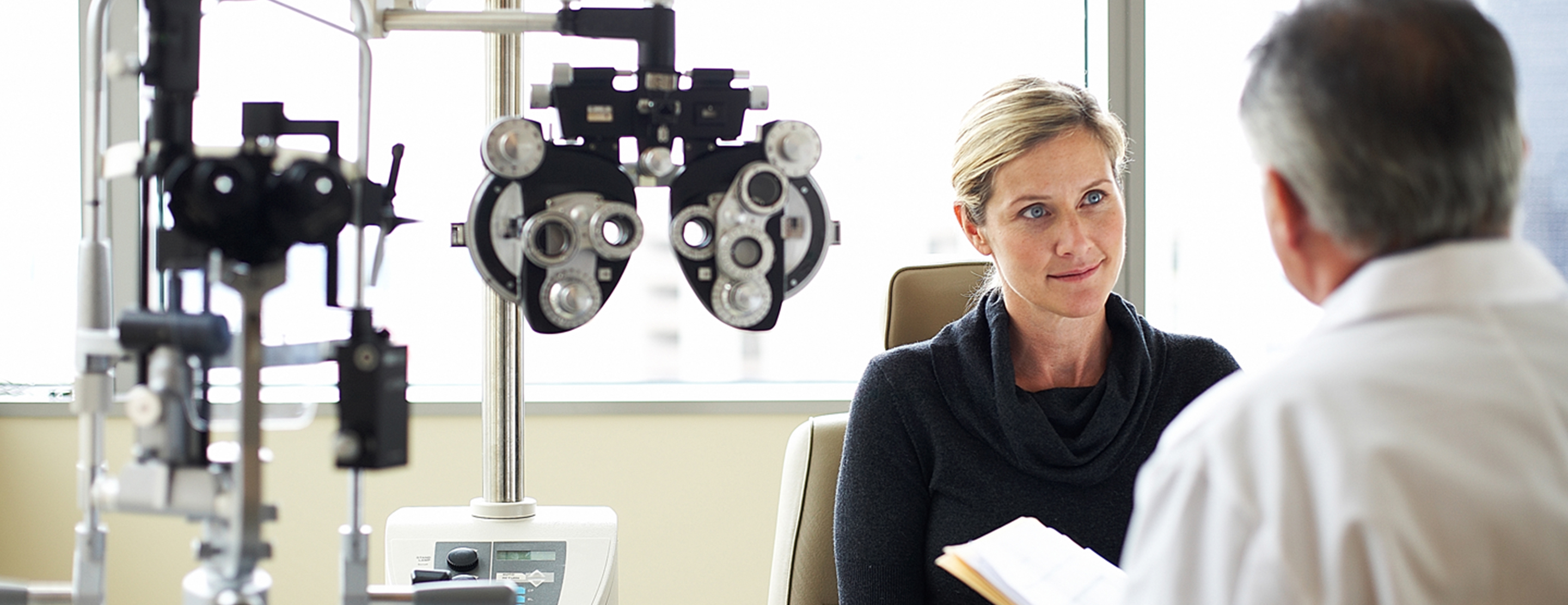
Refraction
Definition
A refraction is an eye exam that measures a person's prescription for eyeglasses or contact lenses.
Alternative Names
Eye exam - refraction; Vision test - refraction; Refraction
How the Test is Performed
This test is performed by an ophthalmologist or optometrist. Both of these professionals are often called "eye doctor."
You sit in a chair that has a special device (called a phoroptor or refractor) attached to it. You look through the device and focus on an eye chart 20 feet (6 meters) away. The device contains lenses of different strengths that can be moved into your view. The test is performed one eye at a time.
The eye doctor will then ask if the chart appears more or less clear when different lenses are in place.
How to Prepare for the Test
If you wear contact lenses, ask the doctor if you need to remove them and for how long before the test.
How the Test will Feel
There is no discomfort.
Why the Test is Performed
This test can be done as part of a
For people over age 40 who have normal distance vision but difficulty with near vision, a refraction test can determine the right power of reading glasses.
Normal Results
If your uncorrected vision (without glasses or contact lenses) is normal, then the refractive error is zero (plano) and your vision should be 20/20 (or 1.0).
A value of 20/20 (1.0) is normal vision. This means you can read 3/8-inch (1 centimeter) letters at 20 feet (6 meters). A small type size is also used to determine normal near vision.
What Abnormal Results Mean
You have a refractive error if you need a combination of lenses to see 20/20 (1.0). Glasses or contact lenses should give you good vision. If you have a refractive error, you have a "prescription." Your prescription is a series of numbers that describe the powers of the lenses needed to make you see clearly.
If your final vision is less than 20/20 (1.0), even with lenses, then there is probably another, non-optical problem with your eye.
The vision level you achieve during the refraction test is called the best-corrected visual acuity (BCVA).
Abnormal results may be due to:
Astigmatism (abnormally curved cornea causing blurred vision)Hyperopia (farsightedness)Myopia (nearsightedness)Presbyopia (inability to focus on near objects that develops with age)
Other conditions under which the test may be performed:
Corneal ulcers and infections - Loss of sharp vision due to
macular degeneration Retinal detachment (separation of the light-sensitive membrane (retina) in the back of the eye from its supporting layers)Retinal vessel occlusion (blockage in a small artery that carries blood to the retina)Retinitis pigmentosa (an inherited disorder of the retina)
Risks
There are no risks with this test.
Considerations
You should have a complete eye examination every 3 to 5 years if you have no problems. If your vision becomes blurry, worsens, or if there are other noticeable changes, schedule an exam right away.
After age 40 (or for people with a family history of
People with a refractive error should have an eye exam every 1 to 2 years, or when their vision changes.
References
Chuck RS, Jacobs DS, Lee JK, et al; American Academy of Ophthalmology Preferred Practice Pattern Refractive Management/Intervention Panel. Refractive errors & refractive surgery Preferred Practice Pattern. Ophthalmology. 2018;125(1):1-104. PMID: 29108748
Feder RS, Olsen TW, Prum BE Jr, et al; American Academy of Ophthalmology. Comprehensive adult medical eye evaluation preferred practice pattern guidelines. Ophthalmology. 2016;123(1):209-236. PMID: 26581558
Wu A. Clinical refraction. In: Yanoff M, Duker JS, eds. Ophthalmology. 5th ed. Philadelphia, PA: Elsevier; 2019:chap 2.3.
Review Date: 02/28/2019
The information provided herein should not be used during any medical emergency or for the diagnosis or treatment of any medical condition. A licensed physician should be consulted for diagnosis and treatment of any and all medical conditions. Call 911 for all medical emergencies. Links to other sites are provided for information only -- they do not constitute endorsements of those other sites. Copyright ©2019 A.D.A.M., Inc., as modified by University of California San Francisco. Any duplication or distribution of the information contained herein is strictly prohibited.
Information developed by A.D.A.M., Inc. regarding tests and test results may not directly correspond with information provided by UCSF Health. Please discuss with your doctor any questions or concerns you may have.





